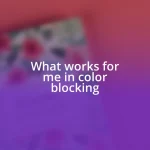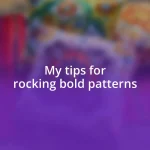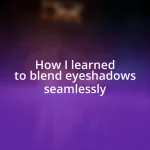Key takeaways:
- Understanding and experimenting with makeup textures can transform both the look and feel of makeup, enhancing creativity and personalization.
- Utilizing different application tools (brushes, sponges, fingers) significantly alters the texture effect and final appearance of makeup.
- Adapting makeup routines to suit individual skin types and preferences is essential for achieving satisfaction and expressing personal style through textures.
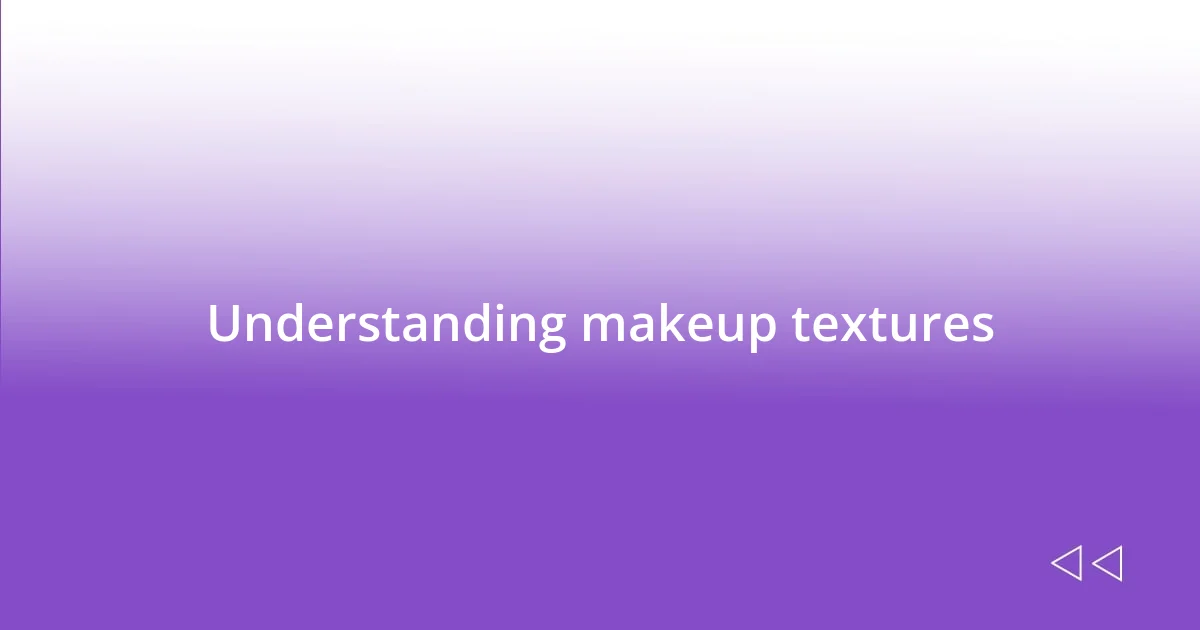
Understanding makeup textures
When it comes to makeup, understanding textures is crucial to achieving the desired look. I remember the first time I experimented with a cream blush; the application felt so smooth and buttery. That experience made me realize how texture can completely transform not just the look but also the feel of makeup on the skin.
Different textures serve unique purposes, and I often find myself asking, “What mood do I want to create today?” For instance, a matte foundation can convey a more polished look, while a dewy finish instantly breathes life into my complexion. It’s fascinating how a subtle change in texture can shift the overall vibe of my makeup.
Exploring textures opens up a world of creativity. Once, I layered a liquid highlighter over a matte foundation, and the contrast was eye-catching! It’s this experimentation that helps me discover what works best for my skin type and personal style. Don’t you find that playing with textures can be almost like painting on a canvas? Each product tells a story, and it’s all about finding the right combination to articulate your unique expression.
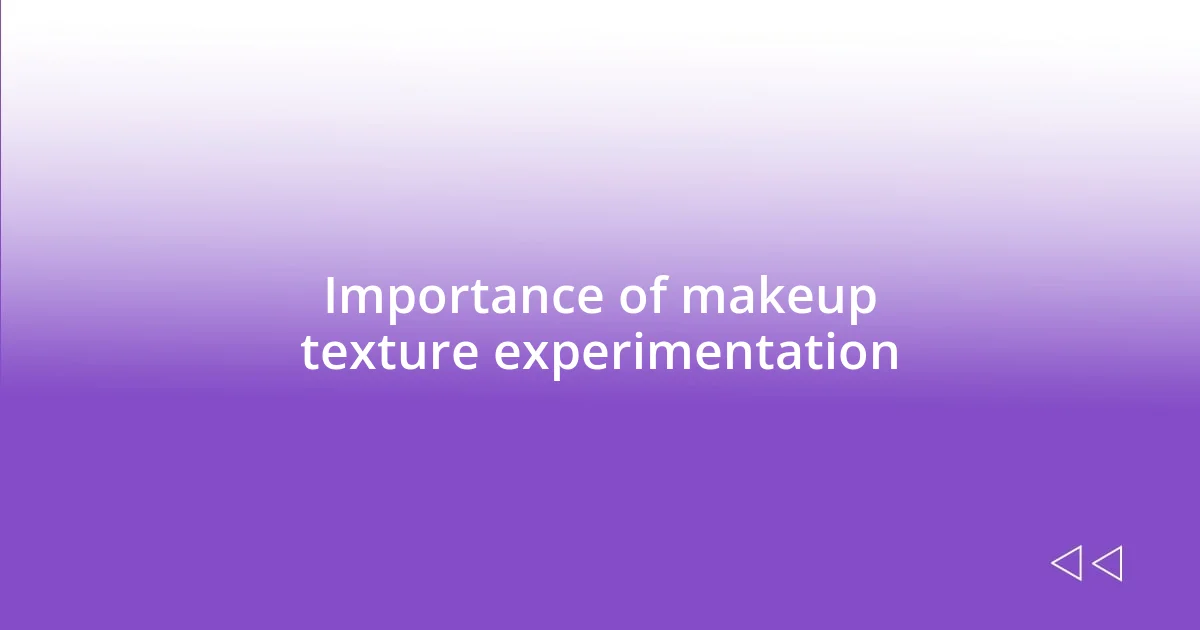
Importance of makeup texture experimentation
Experimenting with makeup textures is essential because it allows for a deeper understanding of how different products interact with your skin and can profoundly influence your overall look. I once decided to dabble with a gel-to-powder highlighter, and the sheer glow it offered was a delightful surprise. It felt weightless and left my skin looking radiant without being overdone, which taught me that experimenting can lead to unexpectedly beautiful outcomes.
Here are a few reasons why texture experimentation is so important:
– Personalization: Different textures cater to different skin types and preferences, helping you find what truly suits you.
– Versatility: Mixing textures can create multidimensional looks, adding depth and interest to your makeup.
– Trend Adaptation: Staying open to new textures can keep your makeup game fresh and in line with current trends.
– Confidence Boost: Finding that perfect texture can enhance your self-esteem and overall satisfaction with your look.
– Skill Development: Experimentation enhances your makeup skills, allowing for better application techniques and choices over time.
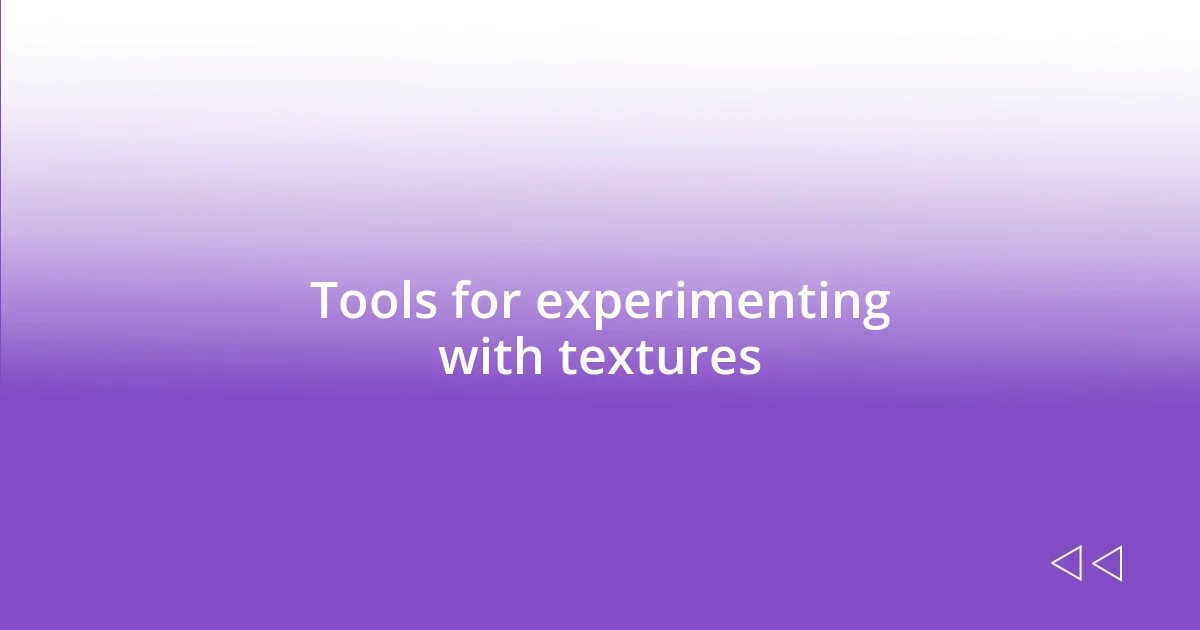
Tools for experimenting with textures
The tools I use when experimenting with makeup textures can really elevate my experience and results. Brushes are a staple; each brush type offers a different application technique, which can change the texture significantly on my skin. For instance, using a dense, flat brush for cream shadows creates a bold look, while a fluffy brush diffuses the color for a soft wash. I remember the first time I switched from my typical fingertip application to a brush; the precision was a game-changer.
Sponges are another fantastic tool, especially for liquid formulations. I love how they can build up texture gradually, allowing for a flawless finish. Damping the sponge before application gives a different effect, creating that beautiful, skin-like sheen that I adore. For me, a well-moistened sponge has become essential in my makeup routine; it’s like magic, turning foundations into second skins!
To top it off, don’t underestimate the power of your fingers! They offer a unique warmth that can really help blend products together. I often find myself reaching for my fingertips when applying cream blush or highlighter—it gives the products a natural, lived-in look. Each tool I choose has a distinct role in my texture exploration, leading me to endless creativity in my makeup application.
| Tool | Texture Effect |
|---|---|
| Brushes | Variable; tight for bold looks, fluffy for soft |
| Sponges | Seamless finish; builds texture softly |
| Fingers | Natural warmth; great for blending and softness |
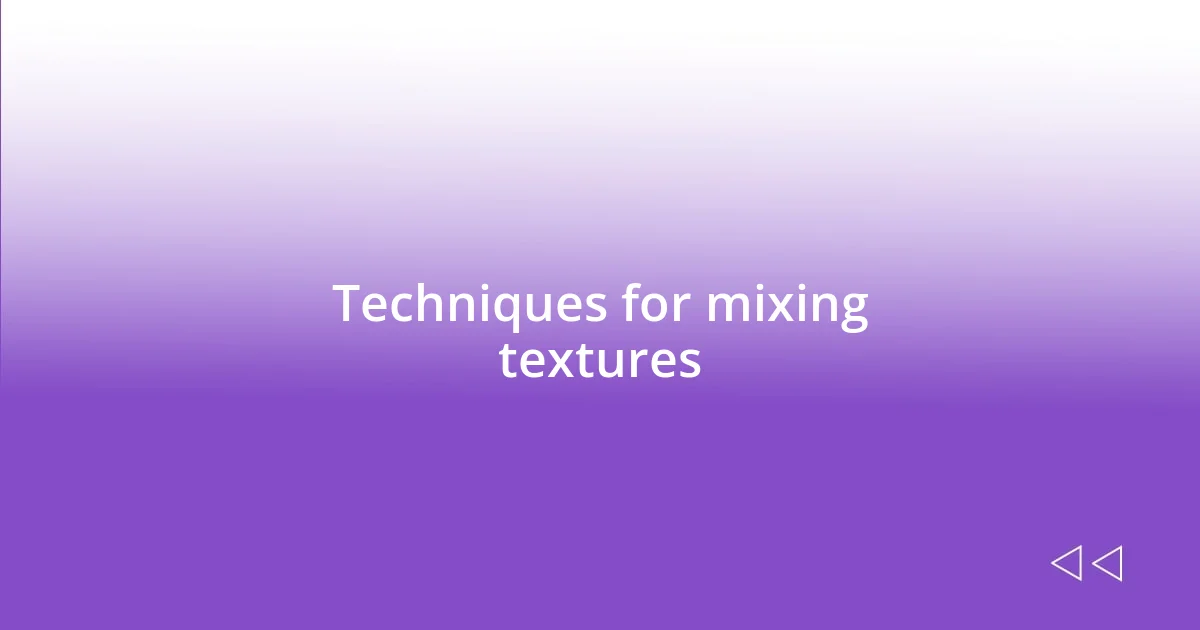
Techniques for mixing textures
Mixing textures can be approached with a few key techniques that I’ve found really enhance my makeup looks. One method I love is layering different finishes. For example, I might start with a matte foundation and then apply a dewy setting spray to certain areas for a subtle highlight. This contrast can create a beautiful, natural glow that feels alive on the skin! Have you tried this technique? It’s remarkable how a simple layer can add dimension to your face.
Another technique I often use is combining cream and powder products. I might apply a cream blush as a base and then lightly dust a powder blush on top. This not only helps with longevity but also creates a soft, blended finish that feels so fresh. The fusion of creamy and airy textures gives my makeup a unique quality—almost like bringing a canvas to life! I remember the first time I experimented this way; it felt like discovering a whole new world of possibilities right on my cheeks.
Lastly, don’t hesitate to experiment with unconventional combinations! A favorite of mine has been mixing a gel eyeliner with a loose glitter pigment for a stunning eye look that’s both striking and playful. Who doesn’t want a bit of sparkle? Trying something out of the ordinary can lead to unexpected results that feel personal and exciting. So, go ahead and test your boundaries; you never know when a new signature look might emerge!
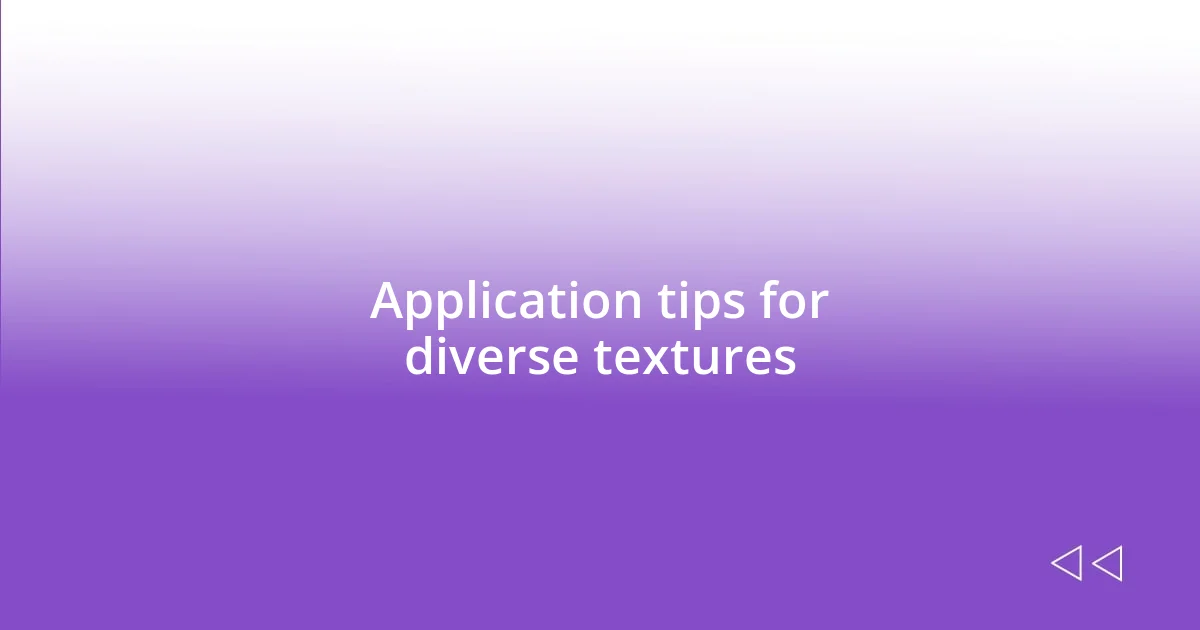
Application tips for diverse textures
When it comes to applying different makeup textures, I find that patience is key. For instance, when using a cream highlighter, I learned it’s essential to apply it with a light hand, gradually building up the intensity. I remember my first attempt where I went in too strong — I ended up looking more like a disco ball than glowing! Honestly, building layers can truly elevate the texture without overwhelming the skin.
Another tip I swear by is using setting sprays to alter textures after application. I once had a situation where my matte finish foundation felt too flat, so I misted a hydrating spray to bring some life back into my skin. The transformation was instantaneous! This trick adds that lovely texture without compromising the longevity of my makeup, and who doesn’t love a little refresh throughout the day?
Lastly, don’t shy away from experimenting with texture combinations on your eyes. Mixing different formulas, like a satin eyeshadow with a shimmer, can create depth that’s downright captivating. I vividly recall creating a look for a night out where I blended a creamy base with a sparkly finish—it felt like magic watching the different light reflections as I moved! Why not give it a try? You might uncover your next go-to eye look, and you’ll be amazed at the transformation it brings!
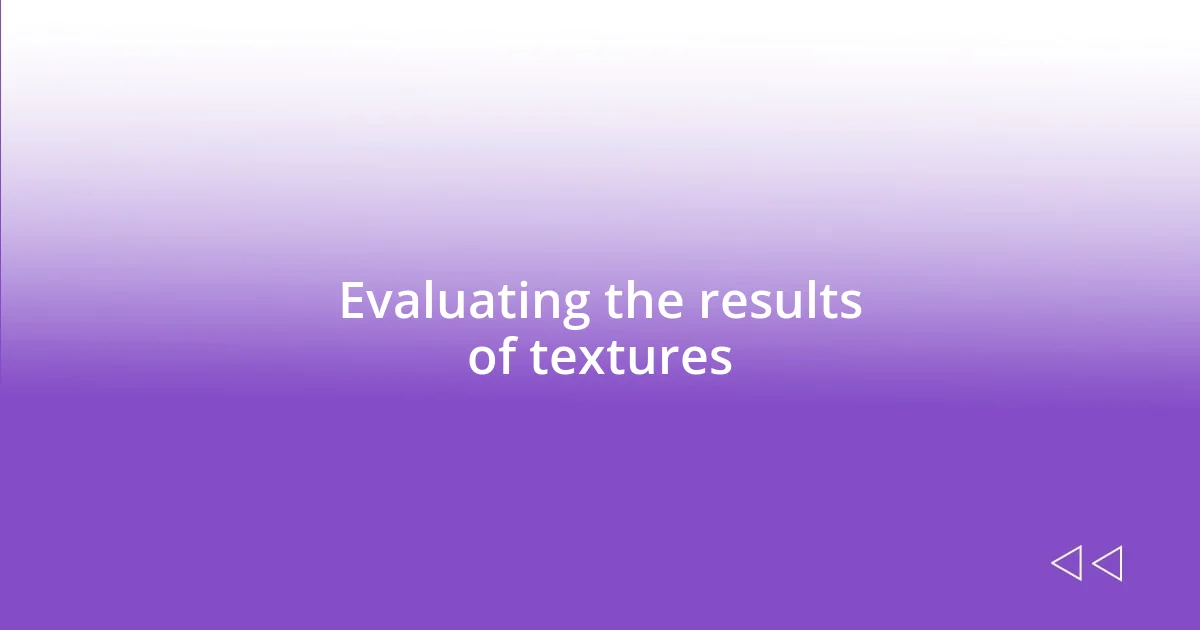
Evaluating the results of textures
Evaluating the results of different textures can be both exciting and enlightening. I often take a moment to really assess how each layer plays with light and shadow on my face. It’s almost like a mini-revelation each time I examine my reflection; am I getting that luminous glow, or is it more matte than I intended? It pushes me to better understand how to manipulate textures for my desired effect.
One standout moment for me was when I experimented with a satin finish versus a matte finish on my eyelids. Initially, I was a bit skeptical about the satin—would it be too shiny? But once I stepped into the sunlight, I was captivated by the subtle sheen that caught the light beautifully. It’s an eye-opener, literally! It’s fascinating how different textures can transform not just the end result, but also the overall ambiance of a look.
While evaluating the textures, I also find it helpful to note how they wear throughout the day. I once applied a cream contour and set it with a translucent powder, expecting it to fade away quickly. To my surprise, it held up beautifully, and I felt empowered by the lasting impact! Have you ever kept a tab on how your textures perform? Tracking these experiences not only enriches my makeup journey but also helps me refine my technique even further.
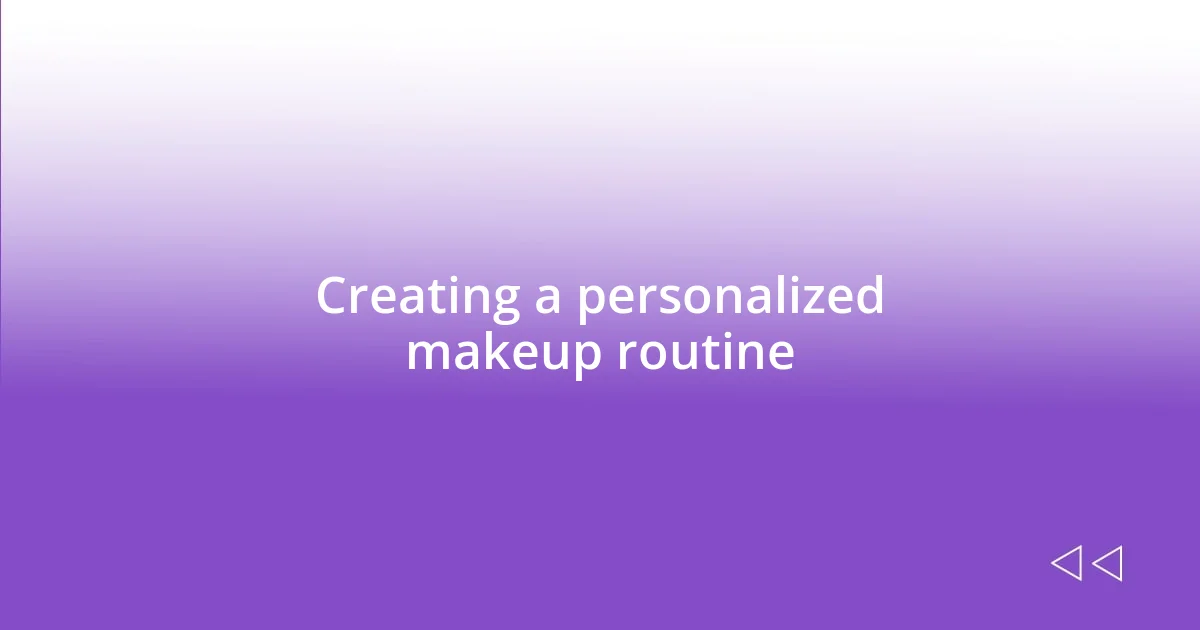
Creating a personalized makeup routine
Creating a personalized makeup routine requires understanding your unique skin type and what textures work best for you. I remember when I first tailored my routine; I had no idea how much my dry skin would thrive with cream products. Initially, I stuck to powders, thinking they’d suit me better. But once I made the switch to creams, the hydration and glow were game-changers! It’s essential to listen to your skin, as it often knows what it craves.
In my journey, I’ve discovered that texture experimenting allows me to express my personality through makeup. For instance, on days when I want to feel bold, I might switch to a glossy lip that instantly brightens my mood. I can’t forget a day where I paired it with a matte foundation; I felt effortlessly chic! How about you? Have you found certain textures that make you feel more like yourself? This exploration makes the makeup routine feel less like a chore and more like a personal art form.
I find it valuable to build a routine based on trial and error. Once, I combined a dewy foundation with a metallic eye — the result was not only beautiful but also gave me that fresh, vibrant look I was aiming for. It taught me that not every combination will work, but those that do can be immensely satisfying. It’s about evolving your routine and discovering what textures resonate with your personality, and that, to me, is the thrill of the makeup world!

